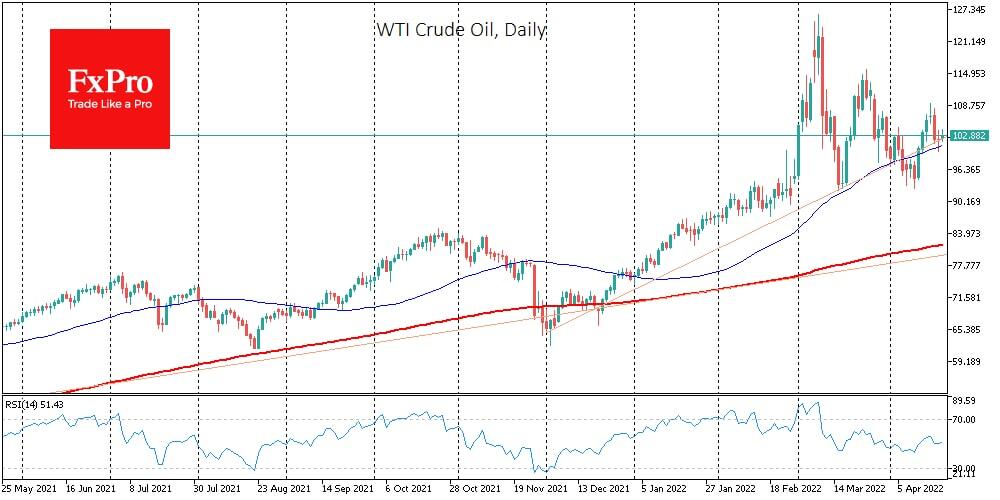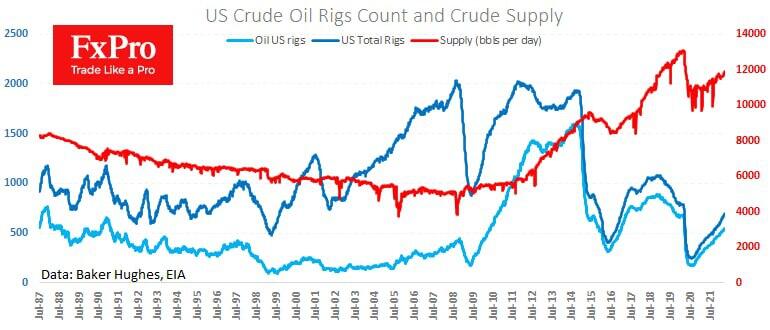Oil gained 1.5% on Thursday morning to $103.75 per barrel for WTI and $108.2 for Brent, continuing to cling to the uptrend since December.
Over the past six weeks, oil price movements are no longer unidirectional, but the market remains in 'crisis mode'. In April, oil is supported on the declines towards the 50-day moving average, as we saw yesterday.
The uptrend is not only supported by the abrupt withdrawal of oil from Russia and the accompanying decline in production there. There are also shipment problems in Libya and prolonged pipeline repairs in Kazakhstan.
Oil producers in the US seem to be stepping up. Last week saw production increase to 11.9M barrels per day - a new high since May 2020 - from 11.8M.
Meanwhile, US oil stocks and production data remain volatile. Commercial inventories collapsed by 8M barrels after jumping by 9.4M last week. Such fluctuations could prove to be a manifestation of the supply shifting to Europe.
Strategic stocks showed a net decline of 4.7M after 3.9m the previous week. The volume of oil in strategic storage fell to the lows in the last 20 years. However, it is not yet enough to turn around commercial inventories.
Oil supply constraints continue to put together a relatively bullish picture for oil, preventing a price reversal to the downside. A real bearish victory requires either a sharp increase in production in the US or OPEC countries or a dramatic fall in demand. We see no clear signals for either direction.
Another potential area of pressure on the oil price - a strengthening dollar - is also failing for the second day in a row, temporarily working on the bulls' side.
Trade Responsibly. CFDs and Spread Betting are complex instruments and come with a high risk of losing money rapidly due to leverage. 77.37% of retail investor accounts lose money when trading CFDs and Spread Betting with this provider. The Analysts' opinions are for informational purposes only and should not be considered as a recommendation or trading advice.
Recommended Content
Editors’ Picks
EUR/USD trades with negative bias, holds above 1.0700 as traders await US PCE Price Index

EUR/USD edges lower during the Asian session on Friday and moves away from a two-week high, around the 1.0740 area touched the previous day. Spot prices trade around the 1.0725-1.0720 region and remain at the mercy of the US Dollar price dynamics ahead of the crucial US data.
USD/JPY jumps above 156.00 on BoJ's steady policy

USD/JPY has come under intense buying pressure, surging past 156.00 after the Bank of Japan kept the key rate unchanged but tweaked its policy statement. The BoJ maintained its fiscal year 2024 and 2025 core inflation forecasts, disappointing the Japanese Yen buyers.
Gold price flatlines as traders look to US PCE Price Index for some meaningful impetus

Gold price lacks any firm intraday direction and is influenced by a combination of diverging forces. The weaker US GDP print and a rise in US inflation benefit the metal amid subdued USD demand. Hawkish Fed expectations cap the upside as traders await the release of the US PCE Price Index.
Sei Price Prediction: SEI is in the zone of interest after a 10% leap

Sei price has been in recovery mode for almost ten days now, following a fall of almost 65% beginning in mid-March. While the SEI bulls continue to show strength, the uptrend could prove premature as massive bearish sentiment hovers above the altcoin’s price.
US core PCE inflation set to signal firm price pressures as markets delay Federal Reserve rate cut bets

The core PCE Price Index, which excludes volatile food and energy prices, is seen as the more influential measure of inflation in terms of Fed positioning. The index is forecast to rise 0.3% on a monthly basis in March, matching February’s increase.

